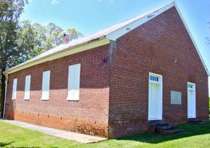
Bethesda Church was used as a hospital for wounded soldiers by both Union and Confederate armies. Approximately 80 unknown soldiers are buried nearby in Bethesda Cemetery.
Constructed of brick in 1835, Bethesda Church, located on Highway 11E east of Morristown, was used as a hospital for wounded soldiers by both Union and Confederate armies. There are approximately 80 unknown soldiers buried nearby in Bethesda Cemetery. The graves are marked with a monument placed by the Disabled American Veterans and Daughters of Confederate Veterans. United States and Confederate flags fly over the graves. Following Lieut. Gen. James Longstreet’s departure from East Tennessee in 1864, several battles were fought as Union and Confederate soldiers contested control of the East Tennessee and Virginia Railroad that ran up the Great Valley of East Tennessee through Morristown, Russellville, and Bull’s Gap. When Confederate Brig. Gen. John C. Vaughan ranged down to Morristown in October 1864, Union troops routed his troops in what came to be known locally as “Vaughan’s Stampede.” In November, Confederate Maj. Gen. John C. Breckinridge returned the favor at Russellville when he stampeded Union Brig. Gen. Alvan C. Gillem’s Tennessee Guard troops in what became known as “Gillem’s Stampede.” During these operations, Bethesda Church was used as a hospital for the wounded. During “Gillem’s Stampede,” a cannonball smashed the eastern wall of the church near the ceiling, passing through the entire building. The walls were so weakened by the impact that it became necessary to brace the sidewalls with a large iron rod anchoring the north and south walls placed near each entrance to the church.
Tools
Key Facts
- Used as a hospital after both “Vaughan’s Stampede,” a Confederate victory, and “Gillem’s Stampede,” a Union victory
- Both Confederate and U.S. flags fly over the graves




